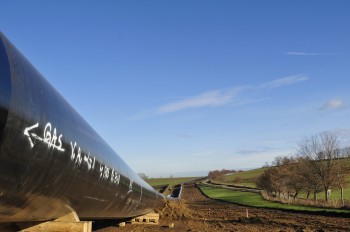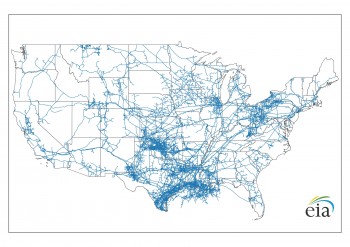Sorting Science from Dread
November 2, 2015

New research shows that risk of serious pipeline accidents overestimated
By Joshua Zaffos
On an evening in September 2010, a cloud of fire exploded above a gas station in San Bruno, California, unleashing an inferno with 300-foot-high flames, killing eight people and injuring more than 50 in the nearby neighborhood. The cause: a ruptured underground natural gas pipeline.
The size and spectacle of such explosions and line failures stick in people’s minds and stoke their fears about the dangers of underground pipelines. Even some industry analysts treat such accidents as inevitable, while environmentalists portray pipelines as inherently perilous ticking time bombs.
But those anxieties may far overshoot actual risks, said Ian Duncan, a research scientist with the Bureau of Economic Geology. Duncan studies the risks of pipeline failures, and has reviewed and analyzed past accident and fatality statistics to better understand just how hazardous different pipelines are. Along the way, he has reached a reassuring, although perhaps unpopular, conclusion: The chance of a person living near a gas or other pipeline dying from a rupture or explosion is close to the probability of that same individual dying from an airplane landing on them in their living room — which is to say pretty low. Duncan’s work suggests that past estimations have overstated risks by up to four orders of magnitude.
“One of the problems in this world is our perception of what’s risky and what’s not risky is catawampus,” said Duncan.
Pipeline Expansion

and program director at the Bureau
of Economic Geology
Duncan’s examination of gas pipelines began as a step toward understanding the risks of another proposed pipeline network: carbon-capture lines that could reduce the release of carbon dioxide into the atmosphere and help mitigate climate change.
Carbon capture and storage (CCS) entails separating carbon dioxide from other gases at electricity generation plants, and then transporting the CO2, usually via pipeline, to be stored underground in geologic formations kilometers beneath the surface. The process has emerged as a promising albeit developing technology to combat greenhouse gas emissions.
Energy companies have used the basic CCS process for decades for enhanced oil recovery — injecting CO2 underground to extract more oil from marginal or dwindling deposits. President Obama’s Clean Power Plan, released this past summer to reduce greenhouse gas releases, included CCS as a possible carbon-reduction strategy for coal plants. But policymakers are still working out whether it will be mandated within the final rule.
Regardless, coal-fired plants are already incorporating CCS. In 2014, the world’s first commercial-scale power plant using CCS began operating in Saskatchewan, Canada, sending recovered carbon dioxide to boost oil recovery in North Dakota. Several other U.S. plants are also upgrading to include the technology; CCS systems will be included in two new coal plants being built in Fort Bend County, Texas, and Kemper County, Mississippi, from the outset.
That development means a lot of pipelines. And outside of the power plant infrastructure, the lines are considered the riskiest element of CCS. Some estimates project that every coal plant could need up to 62 miles of pipelines to effectively move carbon dioxide. To accommodate startup of CCS at just the existing U.S. coal plants, the country could need between 5,900 and 20,610 miles of new pipelines and as much as 120,000 miles at full buildout by 2050. Recent studies of pipeline risk by other experts have suggested this is a hazardous proposition, and have pegged fatality risks from CCS pipelines at 1 in 1,000 people to 1 in 10,000 people per kilometer of line per year. That’s in the range of the risk of working on an offshore oil platform to driving on the freeway, respectively.
“If you’re going to make a policy decision on CCS as a way to deal with climate change, you need to understand the costs and benefits involving alternatives to make a rational choice,” said Eric Bickel, a professor in the university’s Department of Petroleum and Geosystems Engineering, who has collaborated with Duncan.
Without another comprehensive CCS pipeline to evaluate, however, the estimates have generally relied on engineering assessments and raw data from databases, Bickel said.
“Some people have highlighted the risks of transporting CO2, but we need to understand just how big those risks are,” he said. “Rather than theorizing, Ian’s research focuses on actual data from natural gas pipelines or CO2 pipelines used primarily for oil recovery.”
With a $2 million grant from the Department of Energy, Duncan took a closer look at the likelihood of pipeline failures in CCS networks and elsewhere, and reached much different conclusions.
Breaking Down the Data

Duncan began by looking at natural gas gathering lines, which carry resources from well pads to processing plants or refineries, and incident reports from those systems as a useful analog. Those lines are distinct from transmission lines, which run from the processing or refining facilities to customer-distribution systems. While gas is much more flammable than carbon dioxide, the size and specs of the gathering-line network provides a useful comparison for the potential CCS pipeline system. After all, there are currently about 240,000 miles of gathering lines across the country, providing a large data set to study. But the task proved to be a complicated one.
In the past, gathering lines were often built to be smaller and withstand less pressure than transmission pipelines. Now, they’re often built with larger diameters, in part, to keep up with the volume and pressure of gas flowing out of hydraulically fractured, or fracked, well fields. Regardless of the specs, though, gathering lines are largely regulated by state agencies, not the federal government. The Department of Transportation’s Pipeline and Hazardous Materials Safety Administration (PHSMA), regulates only about 10 percent of the gathering-line network. When a gas line blew up near Alice in Jim Wells County in 2012 it was a state regulated gathering line. No federal or state agency investigated the rupture, and the company that operated the line never submitted an official incident report.
The number of “significant incidents” reported to PHSMA has increased since 2004. The rising incident trends and the high-visibility consequences of explosions have contributed to people’s “dread factor” over pipelines, and led some researchers and critics to say that building out a vast network of CCS pipelines would face public opposition — and maybe rightly so.
But as Duncan sifted through previous studies and the accident reports and data, he picked up how information gaps and glitches were also skewing risk assessments of pipelines.
First, while incidents were increasing, so was the overall pipeline mileage. Next, Duncan recognized that federal reporting rules only require operators to report gathering-line incidents that involved a serious injury or death, or cost $50,000 or more. Typically, the largest cost was the value of lost natural gas. So, during a moment when gas prices were peaking, a relatively minor episode causing no human harm but releasing enough gas would show up as a significant incident. Further, while other researchers have interpreted the data to infer all incidents as major ruptures prone to explosions, Duncan’s closer look found that 42 percent of reported incidents were leaks and two-thirds of those cases were just pinholes. Only 15 percent of the leaks were caused by punctures.
Past industry and consultant reports have also discounted that pipeline age has significant impacts on pipeline safety and risks of failure. Duncan again found that to be inaccurate, after considering injury and fatality rates as a function of when a pipeline was installed. With advances in materials, building codes and designs, such as increased pipeline wall thickness, one would expect that the failure rate of newer pipelines would decline; Duncan’s analysis of the data demonstrated that risks of serious injury and death have, in fact, fallen off. Just based on the age of pipelines, newer infrastructure is less likely to fail.
“You find a systematic trend that as pipelines become older, the risk does actually increase,” Duncan said, adding that the industry has been replacing older lines.
Finally, despite the increase in reported incidents, personal injuries and fatalities have actually decreased during the same span. Writing in the peer-reviewed International Journal of Greenhouse Gas Control in 2014, Duncan and a coauthor noted, “That incident rates are so poorly correlated with injury/fatality rates demonstrates the problem of using [that] data to represent risk.”
By the time he completed his reviews, Duncan determined that past risk studies had overestimated gas line risks by several orders of magnitude. As far as risks from proposed CCS pipelines, those rates were also overstated. Rather than being 1-in-10,000 odds of a harmful rupture, the probability is closer to 1 in 10 million, or the chances of harm from plane debris or a lightning strike. At the same time, Duncan said it is important not to be complacent about pipeline safety, as natural gas is clearly hazardous.
“Some of those previous research studies were using statistics of pipeline accidents without really going in and looking at the details,” said Bickel. “A couple of incidents in the database were even practice events for first responders, and other researchers counted those as actual accidents. So, there’s a lack of precision that Ian is trying to correct.”
Duncan added, “People making these statements were just looking at the incident rates, and once you understand that the rates are bogus and not robust, rigorous measurements of anything, then you have a totally different perspective.”
Hazard vs. Risk
Duncan’s findings, published in several papers in recent years, have gained attention from industry, state governments and other researchers. Calling his research “informative,” Sue Gander, director of the National Governors Association Environment, Energy and Transportation Division, invited Duncan to present his work at the association’s 2014 shale gas development forum.
“Ian is addressing the tough decisions in terms of policies surrounding carbon capture and storage,” Bickel added, “and he’s using an interdisciplinary approach,” bringing in geotechnical, engineering, and legal and policy dimensions and working with colleagues who can interpret them. “He’s not just focused on a narrow aspect, he’s trying to address the whole problem.”
And whether we realize it or not, that all comes back to risk, and clearly defining what risk is, and separating the fears associated with pipeline explosions from the statistical chances of pipeline failures that result in accidents.
“Many people, including scientists, don’t seem to understand the concept of risk,” Duncan said. “They tend to confuse it with hazard. If something’s hazardous, it’s risky, but that’s not the scientific definition of risk.”
For the record, risk, in terms of scientists, engineers or insurance companies, is defined as the probability, or likelihood, of an incident occurring multiplied by the consequence of that event. Under that lens, decision makers can choose to define “acceptable risk,” or the chance of injury or loss that is considered tolerable by society. A somewhat standard level of “acceptable risk” often used is 1 in 1 million. The U.S. Environmental Protection Agency, for instance, dictates that if a carcinogenic chemical doesn’t cause cancer effects in lab tests at that level, it’s an acceptable risk to allow its use.
Of course, most people would say even remote odds of a cancer diagnosis — or a nearby pipeline explosion — are unacceptable.
“When you’re a member of the general public, what you view as an acceptable risk tends to be governed by human emotion — that ‘dread’ of something horrible happening — rather than science,” said Duncan.
Duncan’s research may help ease the dread factor, or at least counter other work that reinforces misperceptions about the safety of both CCS and natural gas pipelines. That will be important in supporting responsible decisions on energy policies, from ongoing gas development to carbon capture and storage, and rooting them in sound science.
“This is largely driven by an interest in public policy,” Duncan said, “and we can’t have good public policy unless we really understand what the risks are.”
Back to the Newsletter